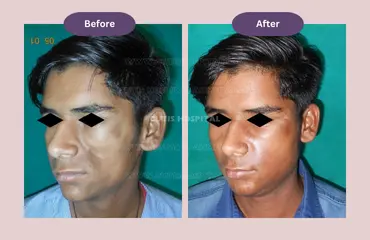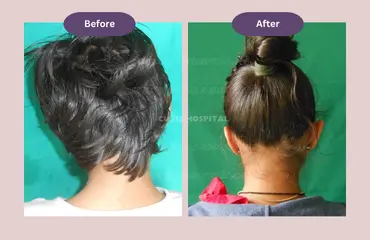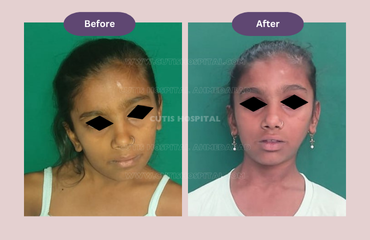Congenital deformity is a physical problem that has been present since the birth of the child. There are plenty of such congenital problems affecting part, half, or whole of the face of a newborn. It is a cause of great concern and anxiety for the parents and family members. At Cutis Hospital, Ahmedabad, we treat such children with the utmost care, compassion, and empathy. We know the importance of a detailed discussion of the problem and its possible solutions with parents. Treatment of many congenital anomalies of the face requires the involvement of other specialists/formation of a team for better outcomes. All these things are explained to the family of the affected child and their questions are satisfactorily answered before we begin the treatment of congenital facial deformity at Cutis Hospital.
Congenital facial deformity is the presence of deformity involving some part, organ, half or whole face of the newborn. Craniofacial anomaly (deformity) is the extension of facial deformity in which different sutures (joints) between two or multiple cranial (head) bones fuse earlier than their predecided natural time. This leads to abnormal shaped growth of head and face along with increased intracranial pressure (pressure within the skull) and many other associated problems. These congenital facial and craniofacial anomalies are sometimes associated with anomalies of other organs or extremities of the patient, leading to a syndrome.
Common congenital facial deformities include cleft lip, cleft palate, atypical clefts of lip and palate, craniofacial microsomia, various congenital ear deformities, coloboma of eyelids, epicanthal folds, hemangiomas, vascular malformations and other not so common yet important craniofacial deformities and syndromes like Apert’s syndrome, Crouzone's syndrome, Pierre Robin sequence and others.
Acquired deformities are the deformities happened due to trauma, infection, operation, burns or such identifiable cause after birth. Small children grows very fast and naturally, the growth is a three dimensional phenomenon. When any amount of scarring occurs in a small child, it invariably restricts the growth to certain extent. This restricted growth causes the deformity of affected part of the face, thus it is called acquired deformity.
There is no definite cause identified for congenital facial deformities. However, scientists have been able to link some of the below-mentioned causes with the occurrence of congenital facial deformities.
Babies and children with congenital facial deformities need to be examined by an expert plastic surgeon immediately or as soon as possible after birth. Majority of the children with these problems require surgical correction for their deformity. However, timings and pre operative planning are different for each deformity. Many complex deformities require staged surgeries with formation and involvement of a multidisciplinary team comprising of craniofacial plastic surgeon, neurosurgeon, reconstructive plastic surgeon, orthodontist, speech therapist, child psychologist and rehabilitation expert.
At Cutis, we have an established plastic surgery unit with round-the-clock availability of an experienced and qualified plastic surgeon. Our anesthesia facility is state of the art which allows us to safely perform complex reconstructive procedures on small children. At Cutis Hospital, we involve other specialists in the comprehensive management of complex anomalies. Even we do not hesitate to involve another plastic surgeon colleague for better outcomes. Postoperative care for small children is extremely important, and our team of surgeons and anesthesiologists is dedicated to the same.




Congenital craniofacial deformities are the deformities affecting head and face and they are present since birth of the child. To name few of them: cleft lip, cleft palate, atypical clefts, deformities of eye, ear, nose, vascular lesions like hemangiomas and malformations, craniosynostosis and various syndromes like Apert’s syndrome, Pierre Robin sequence and Treacher Collin’s syndrome.
Acquired craniofacial deformities are the deformities which were not present at birth but occurred due to infection, trauma (injury), burns, surgery or any such cause. Acquired deformity can sometimes become more pronounced and ‘difficult to correct’ with the passage of time and growth of the child.
Congenital craniofacial deformities can occur due to many reasons. Mainly the reasons could be 1). Genetic: Hereditary transfer of or more causative gene from either parent or from both can produce congenital craniofacial deformities. 2). Environmental causes like pollution, injury, mental trauma, certain drugs, exposure to radiation or similar agents cal lead to these deformities. 3) Folic acid deficiency in early months of pregnancy has definite correlation with development of congenital craniofacial deformity in the baby.
Congenital head deformities are a group of complex deformities which require multidisciplinary approach. At Cutis hospital, these deformities are treated by team approach. The team is usually comprised of: reconstructive plastic surgeon, craniofacial plastic surgeon, experienced anesthesiologist, orthodontic surgeon, speech therapist and in certain cases neurosurgeon and ENT surgeon.
Congenital jaw deformities range from very subtle, barely visible deformities to grotesque and obvious discrepancy with complex deformity of one or both jaws. Minor to moderate degree of jaw deformity usually does not pose great management challenge. However, complex and bilateral/both jaw deformities require multidisciplinary approach. At Cutis hospital, these deformities are treated by team approach. The team is usually comprised of: reconstructive plastic surgeon, maxillofacial plastic surgeon, experienced anesthesiologist, orthodontic surgeon, speech therapist and rehabilitation expert.
Cleft lip and cleft palate are one of the most frequently occurring congenital craniofacial deformities. Surgical correction of cleft lip deformity is usually done at the age of 3 months, provided the child must be having adequate hemoglobin, free from respiratory tract infection and weight of the child should be at par with his age. Cleft palate correction is done now a days at the age of 10-12 months. Subsequent follow up and staged surgeries/procedures are also needed I these children. At Cutis hospital, parents are counselled and explained in details regarding need of staged approach and timing of each intervention from the very beginning.
Cutis Hospital is conveniently located in Ghatlodia, Ahmedabad, making it easily accessible via multiple modes of transportation. Below are the various ways you can reach our facility:
Sardar Vallabhbhai Patel International Airport: Located approximately 12.7 km from Cutis Hospital, offering convenient access for patients traveling from outside the city.
Chandlodiya Railway Station: Approximately 2.4 km from Cutis Hospital.
Ahmedabad Railway Station: Around 11 km from our center.
GSRTC:
Ahmedabad Central Bus Station (GSRTC): About 10.3 km from the hospital.
AMTS:
Bhuyangdev Cross Road Bus Stop: Just 500 meters from Cutis Hospital.
BRTS:
Bhuyangdev BRTS Bus Stop: Only 170 meters from our center.
We provide effective surgical and non-surgical treatments for all parts of the body. At Cutis Hospital, our cosmetic and plastic surgery team is committed to giving patients safe and high-quality care.